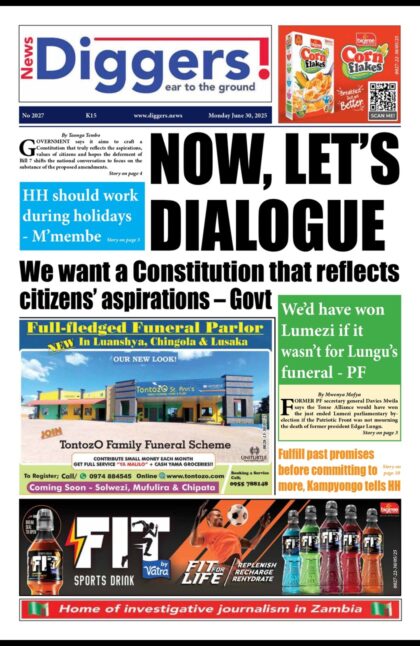There is something we find amiss from Minister of Finance Dr Bwalya Ng’andu’s press conference, February 12, 2020. In the data which the minister released, specifically on paragraph 2.17 of his press statement, he notes that international reserves were US$1.45 billion as at end of December, 2019 (equivalent to 2.1 months import cover) while at the end of June, 2019, reserves were US$1.41 billion (equivalent to 1.6 months of import cover). There is something fishy here.
Firstly, it must be noted that the Bank of Zambia and the International Monetary Fund (IMF) have only published data on reserves through end November 2019. Now, according to the Central Bank, end of November reserves were $1.35 billion. This is US$100 million lower than the claimed end of December figures from the Honourable Minister of Finance last week. It is really hard to see how this could be the case.
Our analysis is that December external debt service should have been something like $75 million and, looking at historic profiles, mineral royalty payments shouldn’t have been expected in that month. So, how was it possible for reserves to have increased? This is being very non-transparent. It is being elusive with the truth. The end-2018 reserves were $1.57 billion. So, even if the Minister’s end-2019 data is correct, it still reflects a loss in reserves.
On domestic arrears, the Minister noted that these increased by an astonishing
K6 billion in quarter three of 2019. He did not say anything about what happened to domestic arrears in quarter four of 2019, and only noted that they had managed to clear (on a gross basis) about K 1 billion owed on road works in December 2019. Now look at this, on domestic arrears, the 2020 Budget notes that it will: (i) increase the allocation of funds (to K2.3 billion) to reduce the stock of domestic arrears; (ii.) use of debt swaps to liquidate part of the outstanding arrears; and (iii.) enhance commitment control systems to curb further accumulation.
The minister’s statement did not include anything about the liquidation of arrears through debt swaps. Right now, domestic arrears are interest-free loans
from suppliers and workers to the government, whose real value is reduced by the rate of
inflation. That helps government finances in the short-term. The flip side is that it is a big drag on the economy and a disaster for honest suppliers and workers. So, it breeds corruption.
On the visit of the IMF team, the Minister said: “Based on the outcome of the mission in November and the debt and fiscal measures I just alluded to, Government will work with the IMF to define a working relationship with them and determine the nature of its support to the Government.” So, the Minister faces a couple of big problems. First, last year’s budget deficit was 8.2 per cent of GDP – 1.7 percentage points above an already excessive target. (The Minister noted that missed spending targets were partly due to the exchange rate and inflation. He didn’t bother to note that these same factors also partly accounted for the better-than-targeted revenue performance).
Second, the outlook for 2020 isn’t helped by coronavirus and the associated weakness in copper prices, continued load shedding and disruptions in the copper sector. The deficit targeted in the 2020 budget is larger than the IMF would have required under an
Agreement. And given the weak economy and lack of adjustment, the budget deficit is likely to be exceeded in the course of its implementation.
The Minister said, “We have written and advised the Fund of the measures that Government is undertaking to address debt sustainability. The next engagement with the Fund will be held from 18th March to 1st April, 2020.” It sounds like the PF government is aiming to agree with the IMF on a “staff-monitored programme ”, which would establish a performance record that would be the basis for entering into a formal arrangement with an associated cash disbursement.
But any staff-monitored programme would require a significant reduction in the fiscal deficit and, most likely, initiate significant steps in clearing domestic arrears (and any external arrears Government may have accumulated. Ahead of the 2021 elections, there is no way the Economic Stabilization and Growth Programme government wants to introduce for austerity measures will really be implemented. Dr Ng’andu himself did hint on this when he said he has to deal with political survival.
The big question is: how much longer can the economy continue to muddle along? It is really
hard to predict exactly when a financial crisis will occur. They happen suddenly and, unless
some big player sees what is coming and finds a way to gain an advantage by unleashing the crisis, they tend to be triggered by unexpected events.
This is a fact! As miserable as adjustment programmes can be, the suffering, dislocation and long-term losses associated with financial crises are worse. This is a political problem. There needs to be a better public awareness of how bad the economic and financial situation is, and clear support for who will bear the burden of the adjustment. This is not easy at all, especially when the PF government is very economical with the truth.
The only honest truth that Dr Ng’andu said during that press conference is that, at US$11.2 billion, the IMF demand for debt from Zambia is like being given an umbrella after the rains have passed. We agree absolutely with the minister. In other words, asking Zambia to become debt cautious at this stage is simply flogging a dead horse, or attempting to evacuate a Titanic that is already at the bottom of the sea.



















